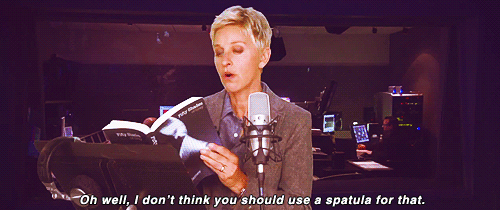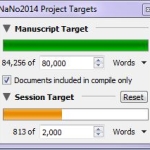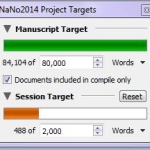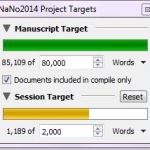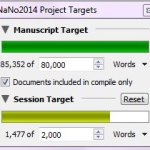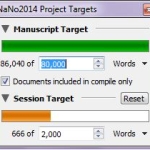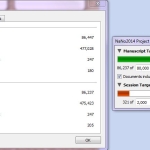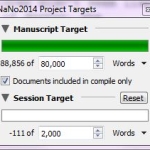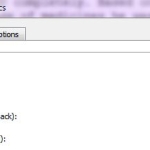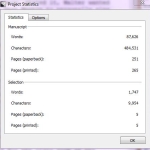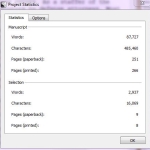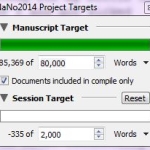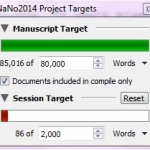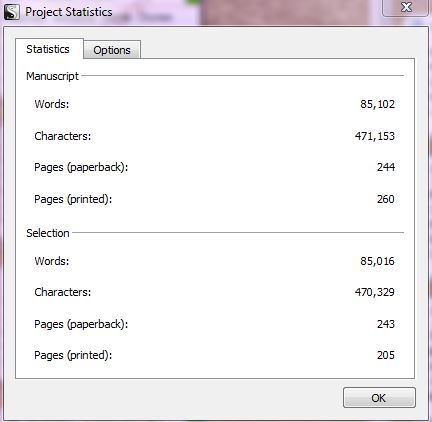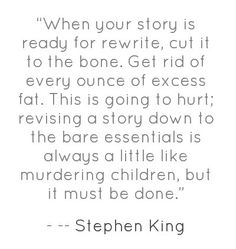NOVEL PROGRESS
SIX MONTHS AFTER NANOWRIMO ENDED – WHERE AM I?
AMBER LOVE 02-JUNE-2015 To give you an idea of where I am in the state of creating this novel, I’ve had this post as a blank draft for weeks and keep moving it down my queue.
SIX MONTHS LATER
I’m not specifically sure what this revision number would be, but as far as having completed files that I’ve tested the compiling for (a Scrivener thing), I’m calling it Revision 1.2.
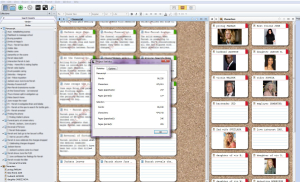
I’ve done at least two full passes with the file in Scrivener; I’ve had a friend edit the first 25%-30% of the chapters. I’ve now removed a couple chapters entirely and compiled the document for Kindle (.mobi). This is so that I can read through it yet again and find more typos and sentences to cut. I’m definitely not alone in a method like this. Lots of authors print out their file because the simple change in how your eyes are seeing the letters can make things stand out where they would have passed over them before on your computer screen. Since I’m not interested in printing each draft of this – my printer is in the attic collecting dust – I’m using the Kindle and find it’s been helpful.
EMOTIONAL ROLLER COASTER
I did what people suggested and walked away from the project for a while to go work on other things. This was hard!
I had no idea that I would feel the physical and emotional nervousness that I had just by not looking at this novel. The cool effect that NaNoWriMo had on me was that, by halfway through November, I WANTED to write this book more than ever. I wanted to open it every day and get more done.
Some of my anxiety about walking away from it was that I feared I would not want to go back to it. And… that’s what happened. It took me a long time to embrace editing and I’m honestly not really there yet.
With Theolyn’s help on the early chapters, I felt like something was getting done; she was finding errors and would question me on paragraphs that weren’t making sense. We were cruising along. My feelings though were distant. I was starting to hate my book again.
There were definitely weeks when I didn’t look at it at all. I did have other projects to do like launch the Patreon, do my weekly podcasting and blogging, write a short story for an important charity anthology, and pitch a graphic novel.
One month was dedicated just to the graphic novel script which needed more characters and eventually grew to a length I’m happy with. Unfortunately, I just heard over the weekend that the publisher is not interested in that particular kind of story. And that’s another story that I toiled with for a few years to get it to where it is.
HATING LIFE MORE THAN MY MANUSCRIPT
As you probably know, I lost my full-time job last summer. Almost a year later and I’ve only had one interview and three paying freelance projects. I spent Memorial Weekend in bed for three days. I’ve been covered in itchy, painful hives since January because of the stress. Some days it hurts to bend my fingers. Fabric can cause a lot of discomfort so I’m basically drugged on a lot of Benadryl and Claritin and sleep a lot.
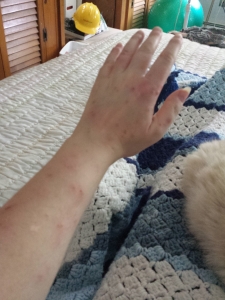
I am, in a nutshell, feeling quite done with life. This feeling is my normal. Don’t be alarmed.
That’s not stated to garner some kind of sympathy. It’s taken many years to get to the point where I’m actually okay saying this. I’m now comfortable with my depression enough to talk to most people about it. I’ve spent years questioning the diagnosis because now, I don’t think it’s accurate.
I’ve interviewed a bunch of people on Vodka O’Clock about working creatively while dealing with issues like mental illness or other medical conditions. My hope was that I’d find their stories inspiring and motivating. If they can keep going, I should be able to. I should be able to get through this manuscript since I’m not at a job 10 hours a day, and find an agent, and find a publisher.
I can feel momentarily better in those fantasies. The reality is, it often takes several years to get that done (years where bills haven’t magically disappeared). I have read a lot of magazine articles and blogs about authors. The range seems to be three to seven years to get a first novel published traditionally.
This realization is why I lean more towards the author/publisher method than traditional publishing. What’s that? It’s a fancy new way of saying self-publishing that is supposed to take the stink off of the process which was considered “inferior†or the only way untalented people could get books made.
The thing is… absolute crap gets traditionally published (I’m looking at you, E.L. James) by people who can’t write, but have found ludicrous success. There’s goddamn bestiality erotica making authors rich enough to quit their day jobs.
So to me, publishing the indie way is not a stigma at all. I still want to be represented by an agent and want traditional publishing for a few reasons like having someone else to print the books, store them, and maybe – just MAYBE – market them. That’s super rare, by the way. Not everyone is James Patterson or Dan Brown with TV commercials to boost sales. Hell, I’d be happy if Kirkus could review my book, but they’re premier – they cost money. Even getting the advanced copies on NetGalley to give access to book bloggers costs a lot of money. That’s money I don’t have.
METRICS OF THE REVISION PROCESS
Here are the word counts and other statistics that I would save after most editing sessions. I love this part of Scrivener! I love their graphs and stats. I can see things being done.
During NaNoWriMo, it was all about moving the graph’s bar to the right to get to my goal (for that month it was 50,000 words, but my real goal was 80,000). It felt so weird wanting to see my counter go down instead of up! My rough draft had this story close to 85,000 words.
In May, I was also happy to take a look at my friend’s manuscript. It’s incredible. I got to pick her brain a bit about it and make some typo notes for her too. She’s spent three years to get her book to the point where she’s looking for an agent. She watched her word count fluctuate a couple times in the process and I think her final count is somewhere around 82,000 down from 89,000.
As of today, I’m back at the 22% mark in my Kindle. It was Chapter Six, but I’ve split apart a couple of long chapters. I think it’s now Chapter Eight.
My first really rough draft was completed December 11, 2014 and I had fun blogging all about that. The manuscript was around 83,000 words which somehow grew. Luckily, I was able to test the book in Scrivener to see what it would be like with two chapters removed. I liked them, one particular which gave some back story, but I could hear Stephen King’s voice saying, “Kill your darlings. Kill your darlings. Kill your darlings.” I wouldn’t say they didn’t add to the book because they did add to the process of getting to know the main character, but they weren’t essential for this murder plot. In Scrivener, all you have to do is uncheck the box [Include in Compile] and you can see test the manuscript out.

In the image above, you can see the corkboard in Scrivener. The green color designates a chapter. I used black to mark which chapters I have “off” in my compile settings; these chapters are the ones that are essentially deleted, but my work isn’t actually deleted. I’ve also changed my chapters from “revised draft” to “final draft” even though there may be more polishing if an agent comes on board. These are visuals so I can see where I’ve left off.

